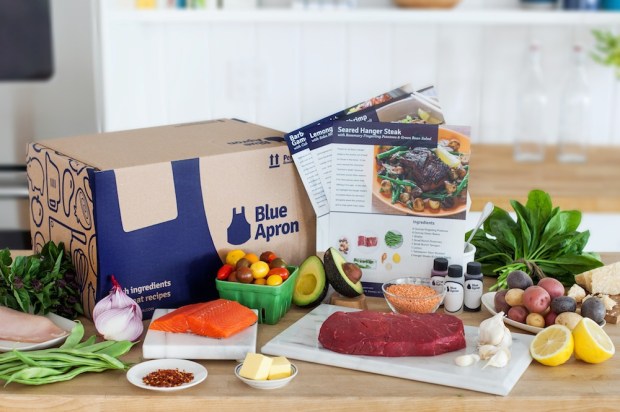Can On-Demand Ordering In New York City Save Blue Apron?

Blue Apron had 2,500 employees and a $2 billion valuation just three years after its founding in 2012. But, more recently, the meal kit provider is taking a new approach to attract customers as it faces a crowded industry and a churn that is endemic in the space. The brand is applying the on-demand model to its meal kit distribution, delivering kits to customers in some New York City neighborhoods via Grubhub and Seamless. Through these on-demand services, consumers will be able to have two- or four-serving meals delivered to their door in custom packaging. And for the sake of convenience, the meals can be cooked in a half hour or less, the company says.
In an announcement, Blue Apron CEO Brad Dickerson noted that the “new on-demand product is a complement to our core offering, giving consumers – for the first time – the option to have a Blue Apron meal delivered to their doorstep in less than an hour.” And, even though the service is just launching, Dickerson hinted at future expansion, saying the company “expect[s] to build on this new competency with additional same day, on-demand platforms over the coming months.”
But the unusual distribution channel does raise the question: Will on-demand delivery work for meal kits, particularly for Blue Apron in the Big Apple?
For starters, experts are wary of the rollout because of the very nature of on-demand platforms. Inherently, consumers often use delivery platforms in order to eat quickly. By contrast, Blue Apron doesn’t provide that same level of speed if consumers do have to cook. As GlobalData Managing Director of Retail Neil Saunders told CNBC, “in that sense, there is a certain incompatibility between the two offers.”
Blue Apron is also rolling out the offering in a city where there are blocks and blocks (and blocks) of food options. The very consumers it is seeking to reach could simply choose to visit a brick-and-mortar store to pick up prepared food – or at least food that is ready to be prepared – on their commute home. As a result, Saunders thinks the meal kit company would be better served by other distribution methods: “Blue Apron should be looking to expand into retail channels, as this is where the biggest opportunity lies,” he told CNBC.
The company alluded to this move months ago. To help grow its customer base, the company said in an early May conference call that it planned to roll out on-demand offerings. At the time, Dickerson said those offerings would come from both its own platform and through other companies, noting that “in our view, we have only scratched the surface of how the Blue Apron meal experience can engage with consumers.”
Meal Kits Go Brick-and-Mortar
Beyond on-demand offerings, Blue Apron has taken a multi-channel approach to its meal kits. The brand has dipped its toes into the world of brick-and-mortar retail with Costco, essentially offering customers a preview of the service at multiple West Coast locations. The goal is to give customers a taste — literally — of what Blue Apron has to offer, in hopes that once their palates are whetted, shoppers might be inspired to not only buy their meal kits from Costco, but also subscribe to Blue Apron to enjoy more of their offerings. As an added incentive, the Blue Apron meal kits were to sell in Costco for less than the meals sent to consumers’ doorsteps.
Blue Apron is not alone in offering meal kits in brick-and-mortar stores. In March, it was reported that Walmart had begun selling meal kits and “one-step meals” in more than 250 of its locations. (Overall, the retailer planned to bring the meals to 2,000 of its stores this year, CNBC reported in March.) In an announcement, Tyler Lehr, senior vice president and general merchandise manager of deli services for Walmart U.S., said “these delicious meals give the best or worst of cooks a fresh, easy option for dinner tonight or later this week.”
Walmart customers can find these meals in the company’s brick-and-mortar store or purchase them through the retailer’s online grocery pickup service. The retailer’s offering is a bit different than Blue Apron’s offering – or that of other services – in that Walmart does not require its customers to purchase subscriptions. Traditional meal kit providers tend to rely on subscriptions to support their business models, which often involve costly and complex delivery processes.
Will the on-demand delivery model work for Blue Apron and help support its business model? That remains to be seen, but the company is hoping that consumers have an appetite for new ways to order meal kits.
